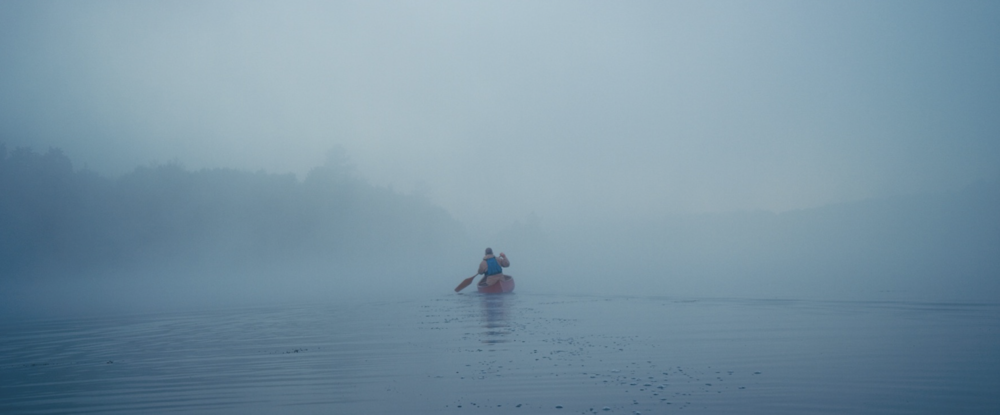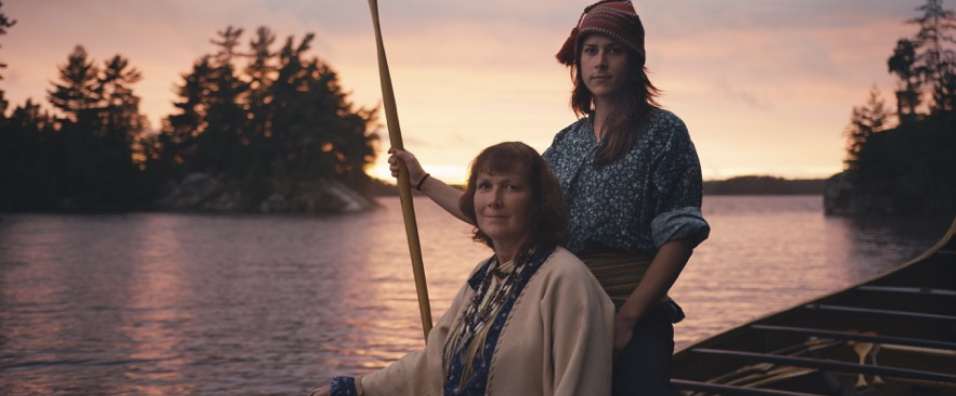

Field Notes Interview: Goh Iromoto, Director & Filmmaker
Goh Iromoto’s career thus far appears to be a seamless combination of environmental circumstance and a love for visual storytelling. Raised on the waterscapes of Northern Ontario, the only child of two journalists, it’s only natural that Iromoto’s two greatest passions — filmmaking and canoeing — are tied to his surroundings.
As a child, Iromoto recalls taking an interest in his parents’ photography equipment and using film to tell stories he couldn’t put into words. His summers were filled with long paddle trips through stunning rivers and lakes, followed by even longer hours in the editing room, stitching his odysseys together piece by piece. It’s not surprising, then, that his latest documentary, The Canoe, focuses on the vessel that has forged invaluable relationships and experiences not only for Iromoto, but for people around the world.
We caught up with Iromoto to discuss bypassing film school, the meaning behind the canoe and how the film came to life. Enjoy.
To start off, I’d like to hear a little bit about your background in film, where you’re from and how you got started.
Goh Iromoto: I was born in Toronto, Ontario. The starting point of all this, I think, can lead back to my parents being journalists. They ran a small community newspaper here in Toronto, and because of that there were cameras available and with us everywhere we went, even if it was a family vacation. That’s where I really got my hands-on experience. I remember a lot of family vacations — I’m an only child, so I didn’t have anyone to play with — I would just be playing around with cameras and filming and whatnot. Fast-forward a number of years, I tried to use video as a tool for school projects to compensate for my writing skills. To this day, I still have an insecurity about those. But that’s where video and filmmaking was able to help me communicate.
Then, not long after that I started to get my first projects and gigs, so to speak. That took me around the world, filming some of these outdoor travel events and show type of contests. Which leads us to my latest project, one based on the canoe.
In Canada the canoe is a symbolic, iconic craft and vessel. It was also something I’d been doing since I was a child. It’s not very common for an immigrant family to be involved in canoeing, but my parents got me into it and as a result I was able to develop a passion for it. In line with filmmaking, it culminated into my latest project.
It sounds like you started filmmaking and working with video at an early age. Was that all self-taught? What were the challenges with that?
So I was self-taught, and I actually have a university degree in Human Geography. It’s an inter-disciplinary subject that mixes in anthropology, economics, political science and physical choreography.
I’d say the challenges to this day may be that I don’t have formal training or educational knowledge, but I think that — especially in this day and age of digital filmmaking — is also my biggest advantage. I’ve found ways to create without feeling obstructed by any of these formalities or traditional methods. Not knowing any of those helped me find my way and work the way that I do — which is quite minimal and independent.
Backing up a bit, what was that first project you referenced that took you around the world, and introduced you to long-form, documentary style?
One of the things that I still do to this day — I got into this when I was in university — is a sport called Free Diving. It’s where you hold your breath and you dive underwater. Any of the underwater shots that you see in The Canoe are shots that I would have taken while holding my breath underwater. And that goes back to my very first job, which was a free diving organization out west, because I went to school at UBC.
It was a client that was a free diving organization and my first gig… what happened was that the organization I was training with gave me 50 hours of footage and I turned it into this promotional video. They got all excited and right away I was filming the World Championships competition in Vancouver. Then they commissioned me to do a documentary on a world record dive for a month and a half in the Cayman Islands. That was crazy because I had just started and they were looking for someone who could tell a story and put together video. And here I was, keen to do anything. That was a really cool experience, it definitely changed me. As a start to filmmaking, that was probably what I would call my schooling. More so than having taken classes and lectures and workshops.
I learned a lot. It was so intense too, because I think it was before YouTube even existed. The client who was running the project had big dreams already of streaming videos to audiences, so my workflow would be to be filming all day long and then staying up all night editing to have something to put online the next day. I remember the resolution being such crap and we had to accommodate for dial-up modem internet still, because some people who were watching would watch videos that way.
It was cool, because I’ve always been involved in sports that are not mainstream. I grew up watching snowboard, ski, and surf videos and films. I think that’s why I got involved in things like free diving and canoeing, giving them a voice. In simple terms, making it look cool, and making it feel cool to be a part of that sport.
Besides your growing up as a paddler, what inspired you to make a long form documentary about the canoe? How did the story come together?
One thing for sure is the landscape and the waterscape here in Canada, in Ontario. I think I was 7 when I started going to the summer kids camp. Then, I became an instructor and an instructor guide.
Throughout all those years, I’ve been paddling around Ontario, seeing the different landscapes — the waterscape has been amazing — and doing all of these little back country trips. Eventually, I got into filmmaking and I’ve been doing projects around Ontario for the last 5 or 6 years… It’s been amazing. Also, meeting people from overseas and the UK, then talking about the landscape was nice, because I sometimes take it for granted. It helped me realize that.
Along with that is hearing people’s stories. It was quite touching to meet all these people who were equally passionate, or had these memories or nostalgic experiences with the canoe. This thing that’s just a vessel was no longer just an object — it became this device that connected people and really affected them and had an emotional resonance.
Speaking of the people that you highlight in this story, how did you cast them? Were they friends, family, strangers?
It wasn’t a traditional casting method. In some way it was a bit of a challenge to find the right combination of people. We wanted to showcase people that fit different scenes and archetypes, not only in canoeing culture but in society as a whole. That’s how we did our vetting process.

It worked out. What I love is the diversity that we ended up with — from an age perspective, culture, ethnicity, race, sex even. It’s actually a total fluke, it wasn’t intentional that the majority of characters are women, which I am quite proud of. I know a couple of months before the film came out, there was a professor at the University of Victoria who made a huge media statement about how the canoe is symbolic of white male privilege. There is a truth to it. I didn’t want to refute her but I really wanted this film to show that there’s a different path being carved out in our society, which goes against that traditional view — something new and different coming along.
In the film there are a couple of shots that seem really vigorous — you’re canoeing through the rapids or what have you. Where those shots difficult to capture?
Logistically, we had a small crew. Basically it was myself and my partner, Courtney Boyd. Between the two of us we did almost everything. From sound, to filming, to camera assisting, to media managing — everything. So, that makes logistics easier in a way, because as long as we could get there with the gear we needed, we can get the shot. The part that made it easy is that the landscape is there. We didn’t have to manipulate it or light it, and as long as we hit the right time of day for lighting, I mean, you’re seeing what we saw.
We were definitely blessed with unbelievable conditions. Some of the shots that you see in there seemed so magical when we were filming — the sunrises sunsets, even the misty conditions. I know they’re common and things that a lot of people can relate to, but at the same time it just seemed so convenient or almost fateful to have these sort of conditions for us.
I think all the water our underwater shots weren’t so much of a challenge, only because it’s the other part of the work I do. So it was more that I was able to apply it as opposed to it being this new challenge to get underwater. The aerial shots were done by drone, and the same thing, I would say that it wasn’t necessarily a challenge. Maybe the challenge was in just being able to work as long days as we did, back to back to back, with such few people.
It seems like a lot of your work is inspired by nature and the beauty of landscapes. Do you think that’s because of where your roots are or is that what you’re most passionate about?
I think the combination of travel, exploration or the outdoor world, along with people. It’s the combination of those things that influence of a lot of the work I do.
It might be my Dad being a big influence. He hitchhiked around the world for 9 years after university, which was a really uncommon thing for someone in Japan to do that back then. So I know his stories and descriptions of different lands definitely influenced me. I knew I wanted to be someone who traveled and explored, and at the same time was able to connect with people. When you emailed me initially, I was in Africa, working on my next project. It’s client-based, but they’re looking for someone who can tell stories, who combines the landscape, wildlife and people. So that definitely seems to be the direction and the type of work that attracts me most.
What process do you go through when you’re finding music for a film?
I guess from the moment I started, music has always been a really important part of the work I do. At one point, when I was in my growing filmmaking years, I worked solely in editing for a couple of years. I definitely learned that music is the element that really influences and affects mood.
For the work I do, it’s super important. In fact, before I lay picture down, 100% of the time I would usually have the music selected and finding that music… It really comes down to the feeling inside. I really have to judge whether I feel something or not.
What’s the most difficult part of what you do, and the most rewarding?
The most rewarding is definitely hearing the feedback from people, and not in an ego-building way necessarily, but actually hearing about the affect it’s had on people’s lives. It’s hearing that a combination of moving picture and music and voiceover can have, not just an impact, but some sort of an emotional experience — a resonance, a reversion back to some sort of nostalgic moment. And then maybe as a byproduct of that, even reflection. To me, that stuff is mind boggling. When you hear the people who take the time to respond to a video about something deep, that’s quite rewarding. It shows that you’ve made a change in a way that’s subtle.
The hardest part is the discipline it takes to craft these types of works. Because I don’t storyboard, I don’t shoot with the exact edit in mind, it’s a very documentary-style approach, which often means filming hundreds of hours of footage and then crafting it together in the edit room.
There were definitely times where I could have passed off as a hermit living in a cave, for many days straight. I thought it was quite funny, because I have an assistant editor and he’s at university still, and he’d often ask these questions like, ‘How do you think of these things?’ I think he might think that I have this flawless work process where I always know what I want, and I always know exactly what to do, and that’s not the case. It’s a process.

